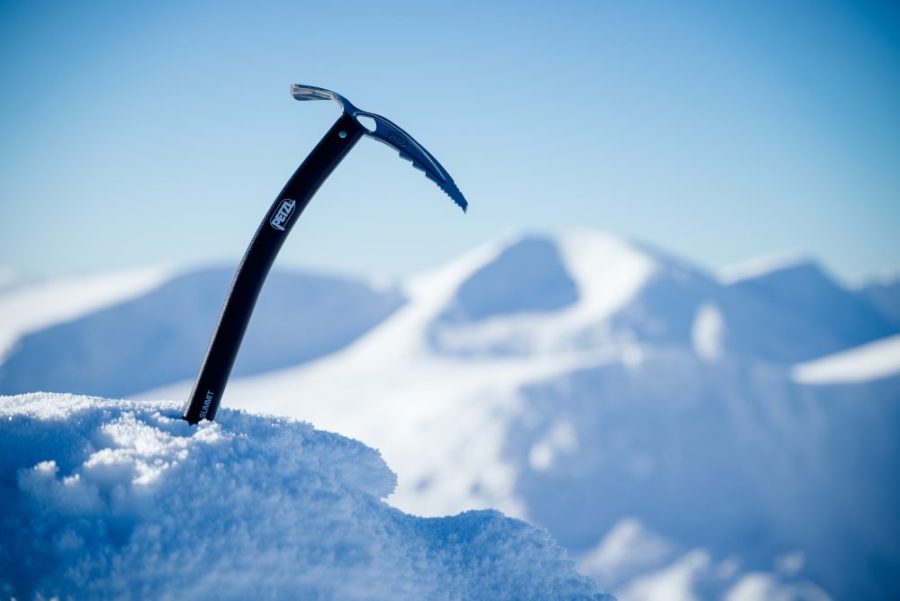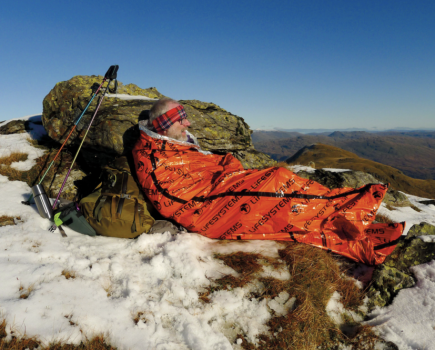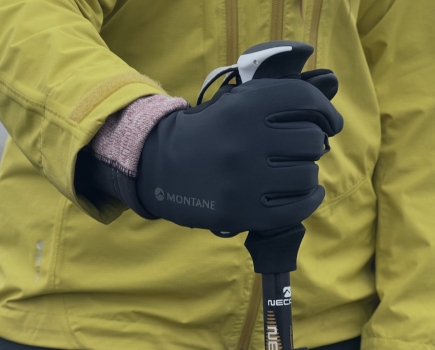Few items of outdoor gear are as personal as an ice axe. It’s a tool of empowerment, opening up new realms that we just can’t access without one: a snowy summit in North Wales, an icy gully in Scotland, picking our way across a glacier in the Alps.
Main image: Petzl Summit in its element | Credit: Alex Roddie
There’s something romantic about an ice axe too. This simple tool has been the icon of mountaineering for over 150 years. Few items are as evocative – and few items will collect good memories as readily. Beyond the objective factors, this is why nobody can really tell you which ice axe to buy. Feel and emotion are important – an ice axe has to be comfortable, and it has to make you feel right when you hold it. This is why I always recommend that buyers should see and hold an ice axe in person before committing.
So what does an ice axe do? It’s a multi-purpose tool to improve your safety on steep snow and ice. It aids balance by providing a third point of contact with the slope. In the event of a slip, a self-belay is often enough to prevent a tumble. The spike and shaft are used for anchoring. If you do fall, an ice axe enables you to self-arrest – although this requires training and practice.
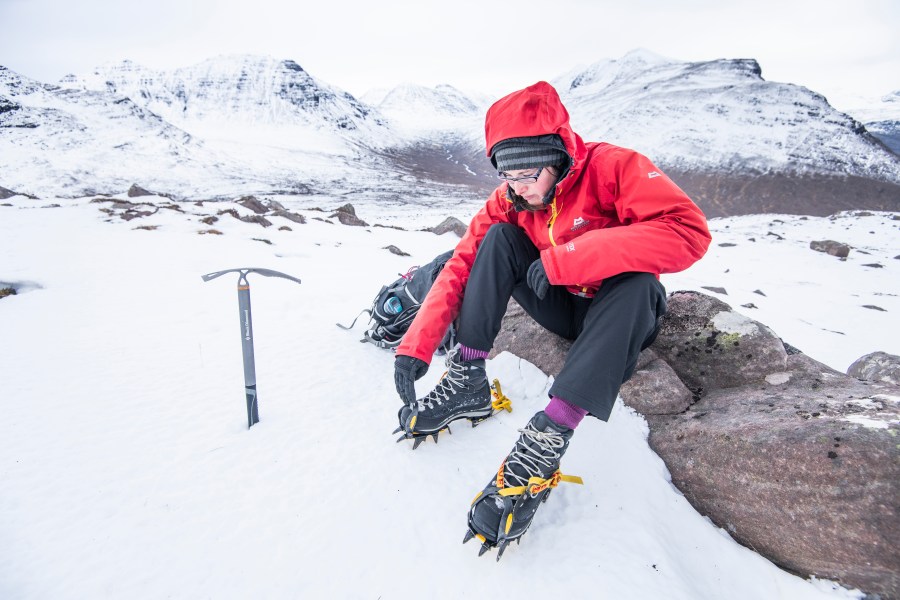
Step-cutting is another important use. Before crampons were widespread this was an axe’s main function, but these days it’s mostly used for crossing a short slope of hard snow if you don’t want to put on crampons (or aren’t carrying them, for example late in the season).
On steeper ground, an ice axe can also be used for direct traction, digging the sharp pick into the slope to provide a secure anchor. The factors affecting your choice of axe include shaft length and shape (straight or bent), pick type (traditional curved or reverse curved, which is more technical), adze, weight, and durability.
The ice axes in this test are all designed for general-purpose winter or Alpine mountaineering. Although most will cope with steeper general mountaineering routes or low-grade climbs (up to about Grade II depending on the climber), they’re intended for straightforward routes on winter hills: walking plus the odd steeper gully. For graded routes requiring ropes and belays, most climbers will prefer twin technical axes.
Black Diamond Raven Pro

Alex Roddie’s Best in Test 2025
Other than its price, this classic ice axe with some welcome updates has just two minor downsides.- comfy to hold
- good range of lengths
- grippiest shaft of all tested
- excellent pick for hard snow and ice
- superb spike
- expensive
- large cutout in adze reduces effectiveness
- no T rating
| Quick specs |
|---|
| Price: £120 |
| Weight: 439g (65cm) |
| Materials: stainless steel head, pick and adze, aluminium shaft, stainless steel spike |
| Technical rating: CEN-B (Type 1) |
| Grip: bevelled metal |
| Leash or Pommel: none |
| Lengths available: 50cm, 55cm, 60cm, 65cm, 70cm, 75cm |
| blackdiamondequipment.com |
The original Black Diamond Raven Pro, with a straight shaft and classically curved stainless steel head, has been my personal ice axe of choice for the last nine years. The new design has a range of tweaks and improvements. The shaft now has a subtle bend near the head and a machined grip near the spike. The shaft also has an asymmetrical cross-section for greater comfort, and the pick now has a more technical angle. The spike is sharper too.
The bent shaft and revised head translate to definite improvements on steep ground. It makes placements overhead better than any other axe tested, and the balance just feels right. I found it a pleasure to use on Grade I/II mixed ground. Downsides? Other than the adze cutout, I would like to see a T rating to match its agility on steeper terrain. The price is also high.
Read more: Alex Roddie’s full Black Diamond Raven Pro review and Lucy Wallace’s 2021 full review of the Raven with a grip
Black Diamond Swift
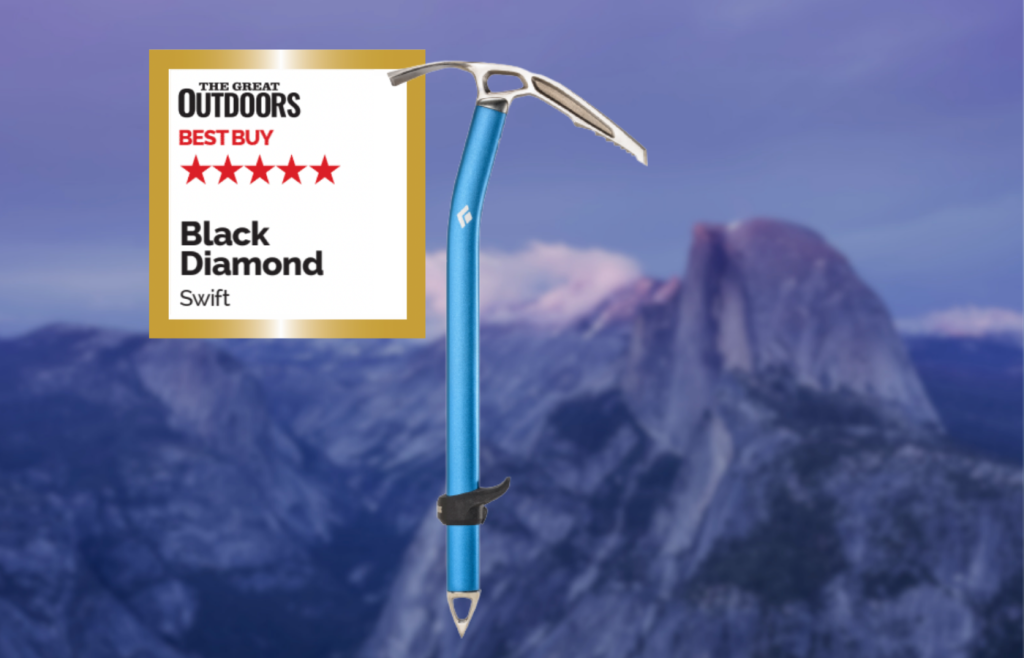
David Lintern’s Best in Test 2023
This is a simple, well-made, T-rated axe that will cover you from hillwalking into climbing.- durability
- adze
- heft
- weight
| Quick specs |
|---|
| Price: £160 |
| Weight: 536g all in (57cm) |
| Materials: Steel head, pick and adze (1 piece hot forged), Aluminium shaft, steel spike |
| Technical rating: Technical (Type 2) |
| Grip: none |
| Leash or Pommel: adjustable pommel |
| Lengths available: 50, 57, 64cm |
| blackdiamondequipment.com |
The Black Diamond Swift is one of the best ice axes on test over the past few years. It is a simple, well-made, T-rated axe that will cover you from hillwalking into climbing. The 57cm shaft is a goldilocks length for me – it’s just right for wielding over my head and long enough I can comfortably use it as a walking stick.
The curve in the Swift is very gentle and there’s no rubber grip – as long as the pommel is pushed all the way to the top of the axe (which is entirely possible), getting the shaft into deep snow is satisfyingly frictionless. The lack of rubber grip also means much less wear and tear at the spike end. An adjustable pommel provides plenty of grip on the tool (and has the advantage over a rubberised handle that it can be replaced when worn). The spike is steel, huge and will take a leash or sling. It offers masses of security when used in walking mode.
Read more: David Lintern’s full Black Diamond Swift review
Petzl Summit
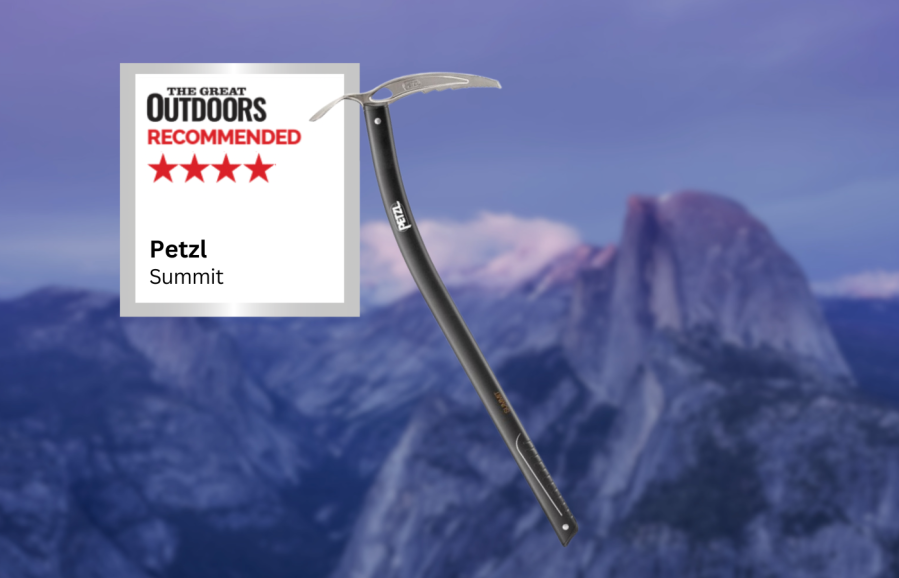
Alex Roddie recommends
Overall, this is a beautiful tool on the technical end of basic mountaineering axes.- lightweight
- comfortable to hold
- good pick for hard snow
- good adze and spike
- expensive
- machined shaft grip not as grippy as it could be
- no T-rating
| Quick specs |
|---|
| Price: £129 |
| Weight: 380g (59cm) |
| Materials: steel head, pick and adze, aluminium shaft, steel spike |
| Technical rating: CEN-B (Type 1) |
| Grip: none |
| Leash or Pommel: none (optional pommel available) |
| Lengths available: 52cm, 59cm, 66cm |
| www.petzl.com |
The Petzl Summit Evo received 4.5 stars and a Recommended rating from David Lintern when he tested it in 2023. This Petzl Summit ice axe is a slightly less technical version, lacking the Evo’s rubber grip and hydroformed aluminium shaft. Otherwise, apart from cosmetic differences, they are similar. Three sizes are available, and although lacking sizes at the longer end they will satisfy most users. It’s a lightweight axe with superb balance that swings exceptionally well.
The shaft’s curve is the most pronounced of all the axes I tested, making it very good for the steep stuff; I found it a pleasure for climbing easy gullies, with its reassuringly aggressive pick that bites well in both snow and ice.
Read more: Alex Roddie’s full Petzl Summit review
Petzl Summit Evo
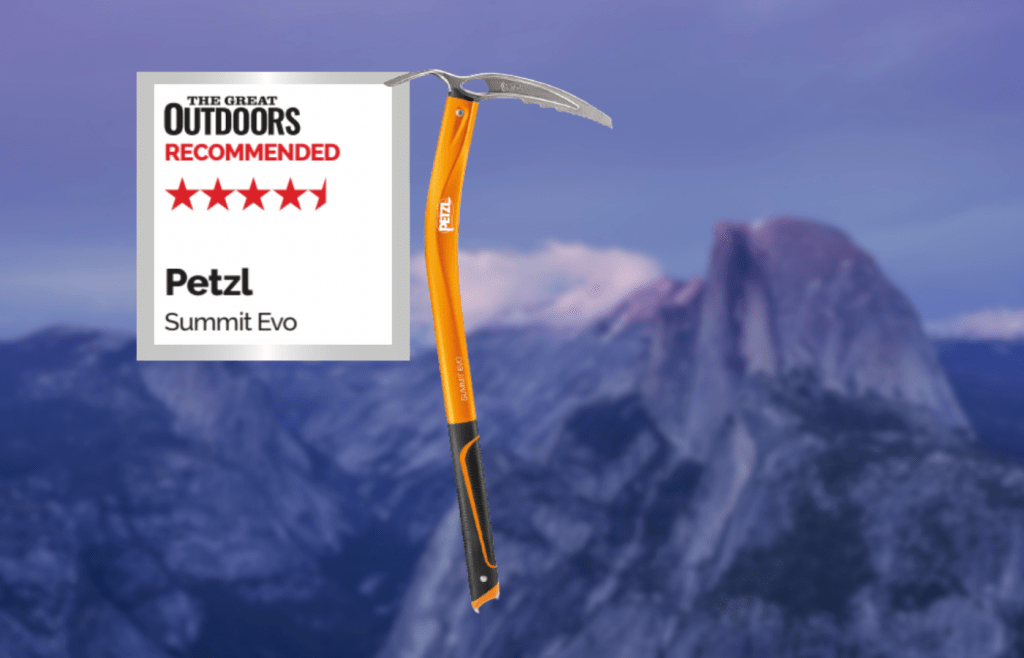
David Lintern recommends
The Petzl Summit Evo is a perfect ice axe for non-technical hillwalking – plus it’s adaptable to steeper ground- big adze
- pleasing weight and balance
- grip prone to wear in walking mode
| Quick specs |
|---|
| Price: £125 |
| Weight: 443g (59cm) |
| Materials: steel pick and adze, aluminium shaft |
| Technical rating: CEN-B (Type 1) |
| Grip: rubberised |
| Leash or Pommel: none (optional leash available) |
| Lengths available: 52cm, 59cm, 66cm |
| www.petzl.com |
The Petzl Summit Evo is a perfect ice axe for non-technical hillwalking that will also adapt for steeper or more technical ground on occasion (outside of rope use). The shaft is ergonomically designed, shaving bulk and weight at the curve which is generous, but sits high enough on the shaft that it’s possible to plunge the spike and shaft into soft snow for extra purchase on a tricky step.
The pick is more than sharp enough (but as long as you are careful, your jacket is safe!) and the adze is well sized to shift snow, yet rounded at the edges to protect fabrics it might otherwise snag on.
Read more: David Lintern’s full Petzl Summit Evo review and Lucy Wallace’s 2021 verdict
DMM Spire
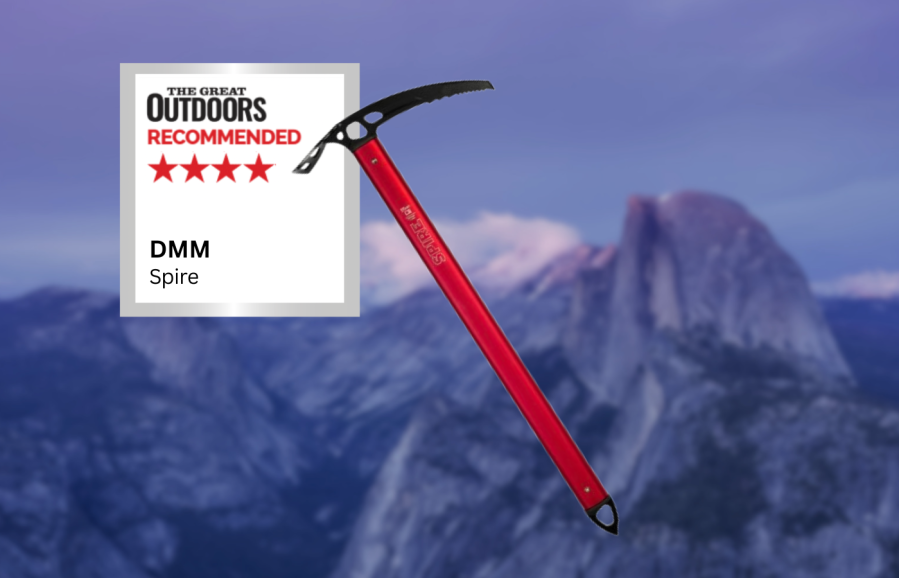
Alex Roddie’s Best Value in 2025
A basic but great value axe which came out top of the bunch as the best axe for step-cutting.- excellent value
- good performance
- good adze and spike
- grippy shaft
- weight
- welded head not as comfy to hold as some
- less positive on steep ground
| Quick specs |
|---|
| Price: £74.99 |
| Weight: 360g (55cm) |
| Materials: steel alloy head, pick and adze, aluminium shaft, steel spike |
| Technical rating: CEN-B (Type 1) |
| Grip: none |
| Leash or Pommel: none |
| Lengths available: 55cm, 60cm, 65cm, 75cm |
| dmmwales.com |
The DMM Spire ice axe is refreshingly no-frills, with a price tag to match. This straight-shafted axe has a welded steel head with a classical curve, and is available in a range of sizes including 75cm. Starting with the shaft, it’s as basic as they come: straight, with oval cross-section, and no grip of any kind. However, the anodised surface does have a surprisingly grippy texture, and at no point did I wish for a leash.
The pick is optimised for snow rather than ice, but I had no trouble climbing a 45° gully of hard névé. This is helped by a good balance in the 55cm sample I tested. The chisel-shaped pick and small but positive teeth all help anchoring in hard snow. It extracts smoothly too. The section near the head is freThanks to the adze and straight shaft, this was the best axe of all tested for step-cutting. Self-arrest was also very positive, with a smooth and controllable action. The spike is sharp, chunky and durable – one of the best of any axes tested. It should stand up to many years of use.
Thanks to the adze and straight shaft, this was the best axe of all tested for step-cutting. Self-arrest was also very positive, with a smooth and controllable action. The spike is sharp, chunky and durable – one of the best of any axes tested. It should stand up to many years of use.
Overall, if you rarely plan to venture onto graded ground and are ok with the compromises, it’s hard to argue against the value of the DMM Spire.
Read more: Alex Roddie’s full DMM Spire review
DMM Spire Tech

David Lintern recommends
The DMM Spire Tech is one of the best ice axes on test, and yet still felt like an ‘in case’ axe.- lightweight in walking mode
- less capable on more technical ground
- grip
| Quick specs |
|---|
| Price: £89.99 |
| Weight: 357g (55cm) |
| Materials: Steel alloy pick, adze and spike, aluminium shaft |
| Technical rating: CEN-B (Type 1) |
| Grip: bevelled metal |
| Leash or Pommel: none (grip can be purchased separately) |
| Lengths available: 45, 50, 55cm |
| dmmwales.com |
The DMM Spire Tech ice axe has garnered plenty of praise, including a previous Best in Test rating from Mountain Leader Lucy Wallace in tests conducted for The Great Outdoors in 2021. There’s a lot to like here, especially the weight.
However, for me, the lack of weight when walking also meant a lack of heft when using the sharp end on steeper ground. I had to do much more work with the DMM Spire Tech than with a heavier tool, and was left wanting something with just a bit more ‘umph’. And because I needed to swing just that bit harder, the lack of rubber grip felt really insecure in the hand. Consequently I found I gripped the handle harder than I needed to – again, fatiguing to use over a longer period. A pommel grip is available separately and I think would be very worthwhile. I also understand there’s a new ‘textured’ surface on the 2023 model which might improve hand-tool friction, too.
Overall, the DMM Spire Tech, despite being one of the best ice axes on test, felt like an ‘in case’ axe to me.
Read more: David Lintern’s full DMM Spire Tech review and Lucy Wallace’s 2021 ‘Best Buy’ verdict
Grivel Airtech Evo
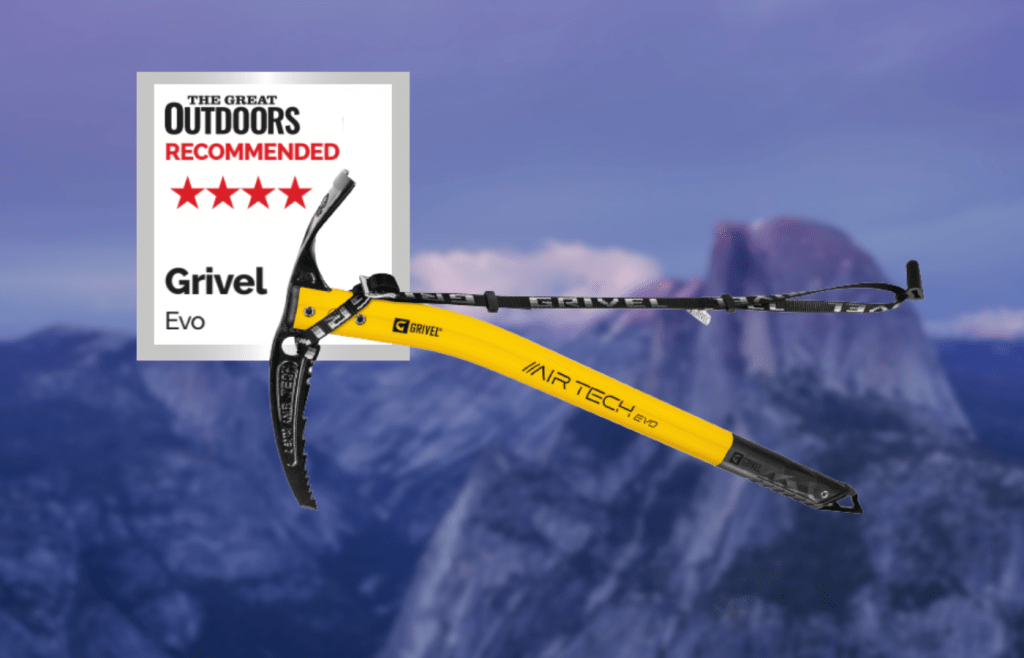
David Lintern recommends
It’s perhaps a touch long for very steep terrain for me, but it’s a great all-rounder.- secure grip
- massive adze
- durability of grip over long term
| Quick specs |
|---|
| Price: £160 |
| Weight: 552g (59cm) including leash, 504g without |
| Materials: Steel head, pick and adze (1 piece hot forged), Aluminium shaft |
| Technical rating: Technical (type 2) |
| Grip: rubberised |
| Leash or Pommel: Leash (48g) and a pommel (called the G slider) can be purchased separately |
| Lengths available: 48, 53, 58, 66cm |
| grivel.com |
I’m very familiar with the Grivel Evo ice axe, having owned one for nearly a decade. It’s a T-rated axe so can take you onto roped climbs should you wish, but although it’s one of the heavier axes in this roundup, it’s still light enough to backpack with (and I have, many times). The 59cm shaft is long enough to make this ice axe very useful in walking mode.
It’s perhaps a touch long for very steep terrain for me, but it’s a great all-rounder. A very gentle curve sits high on the shaft, so plunging the Grivel Evo into soft snow is relatively easy. There is a sharp, hefty pick and a huge adze which clears snow for steps or a ledge with relative ease.
Read more: David Lintern’s full Grivel Airtech Evo review and Lucy Wallace’s 2021 verdict
Grivel Air Tech Light
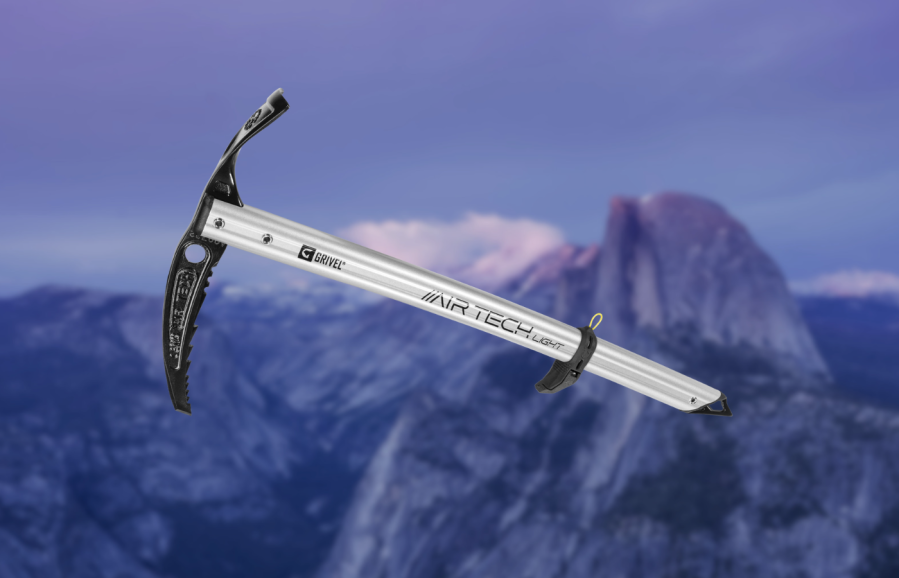
Alex Roddie’s verdict
There are fragilities to this ice axe which let down the excellent one-piece hot-forged steel head.- excellent adze
- good pick performance on ice
- good for self-arrest
- expensive
- smooth shaft hard to grip with gloves
- G-slider pommel is fragile
| Quick specs |
|---|
| Price: £133.95 (with G-slider) |
| Weight: 409g (58cm) |
| Materials: steel head, pick and adze (one-piece hot forged), aluminium shaft, steel spike |
| Technical rating: CEN-B (Type 1) |
| Grip: none |
| Leash or Pommel: pommel (G-slider); available without for £120.95 |
| Lengths available: 49cm, 53cm, 58cm, 66cm |
| grivel.com |
This is a more basic version of the popular Air Tech Evo, which David Lintern gave 4 stars and a Recommended rating in 2023. This version – the Grivel Air Tech Light – lacks the Evo’s rubber grip and Technical rating, and has a different shaft. Although a range of shaft lengths are available, there are no longer options.
Rather than a distinct kink at the head end of the shaft, there’s a gradual continuous curve throughout. In use I found it almost identical to a straight shaft. Lateral grooves are said to allow greater resistance with a lower thickness. However, it’s still a B-rated axe, and not one of the lightest tested.
The one-piece hot-forged steel head is the highlight, with a superb adze that’s the best tested for chopping and cutting. The classically curved pick penetrates hard ice and snow well. A minor downside: the teeth are a bit sharp under the fingers.
Read more: Alex Roddie’s full Grivel Air Tech Light review
Climbing Technology Alpin Tour
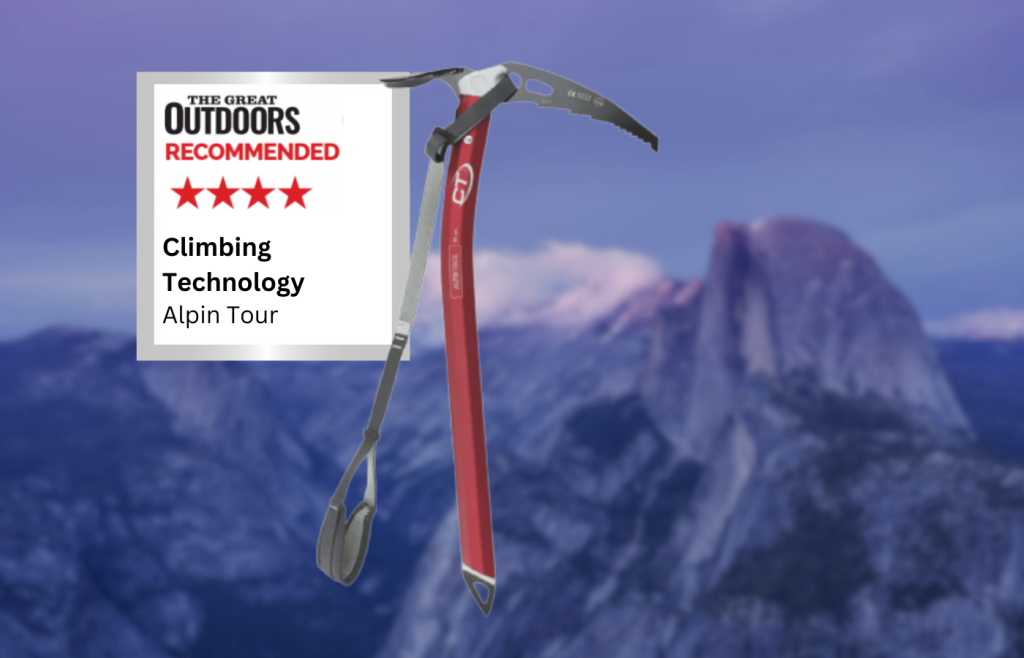
Lucy Wallace recommends
This clunky-looking tool does everything it should at less than half the price of some of its competitors.- excellent value
- uncomfortable head
| Quick specs |
|---|
| Price: £65 |
| Weight: 434g (50cm) |
| Materials: Anodised aluminium with steel alloy head and spike |
| Technical rating: T |
| Grip: none |
| Leash or Pommel: leash included |
| Lengths available: 50cm, 60cm, 70cm |
| www.climbingtechnology.com |
Italy-based Climbing Technology is a brand known for no-nonsense technical gear at accessible prices and the Climbing Technology Alpin Tour is an excellent example of this. The looks are clunky, but this tool does everything it should and is available at less than half the price of some of its competitors. The steel head with a cataphoresis black coating is solid and functional.
The pick is well chamfered with plenty of backward facing teeth of various sizes. The adze is broad and deep. My only gripe is that the top of the head has a pronounced bump that isn’t very comfortable if you have small hands.
Read more: Lucy Wallace’s full Climbing Technology Alpin Tour review
Salewa Alpine-X
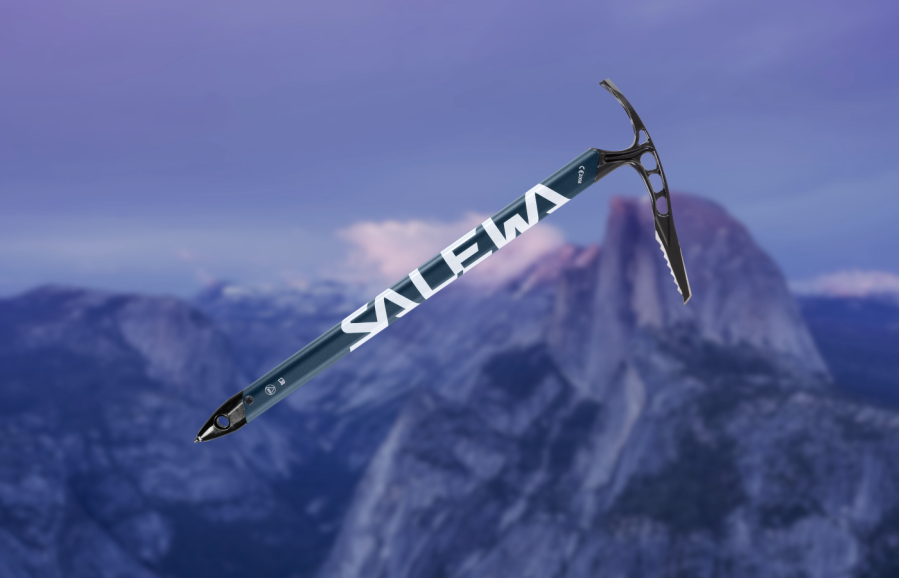
Alex Roddie’s verdict
This lightweight axe with an aggressive pick has some downsides when it comes to climbing and self-arrest.- very light for performance
- pick anchors well on ice
- good adze for step-cutting
- poor spike
- not as effective at self-arrest as others
- limited lengths
| Quick specs |
|---|
| Price: £110 |
| Weight: 390g (65cm) |
| Materials: carbon steel head, pick and adze, aluminium shaft, carbide spike |
| Technical rating: CEN-B (Type 1) |
| Grip: rubberised |
| Leash or Pommel: none (optional pommel available) |
| Lengths available: 53cm, 65cm |
| salewa.com |
The Salewa Alpine-X has a sleek, modern design, largely thanks to its aggressive sculpted head. It’s available in a limited range of sizes. Weight-saving measures include a carbide rather than steel spike, and numerous cutouts in the steel pick.
The straight aluminium shaft is very basic, with no additional grip or included pommel (optional pommel available). The surface texture gives just enough grip for basic use but I’d want to add a leash for cutting steps. It feels less secure to hold in climbing or cutting mode than most of the other axes tested.
Read more: Alex Roddie’s full Salewa Alpine-X review
Salewa Alpine-Tec
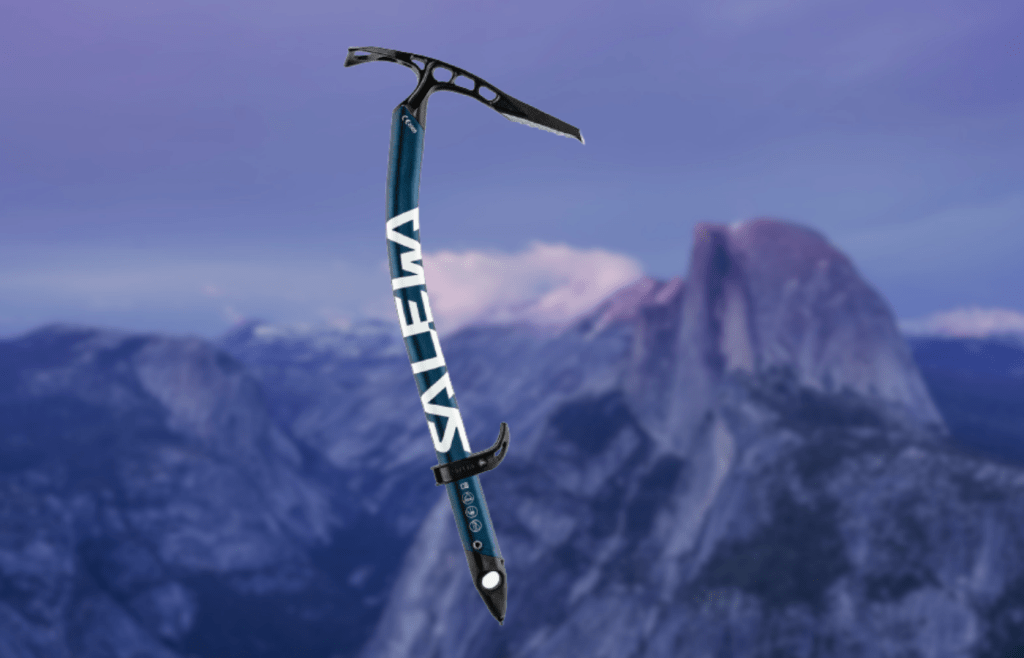
David Lintern’s verdict
A mountaineering axe for a technical, steep terrain, but lacking the length to be much use as a walking assistant.- very sharp pick
- smaller dimensions useful on steeper ground
- less useful in walking mode
- less useful in walking mode, carbide spike insecure
| Quick specs |
|---|
| Price: £115 |
| Weight: 369g (50cm) |
| Materials: Carbon Steel pick, Aluminum shaft, carbide spike |
| Technical rating: CEN-B (Type 1) |
| Grip: none |
| Leash or Pommel: adjustable pommel |
| Lengths available: 50cm, 58cm |
| salewa.com |
The Salewa Alpine-Tec was the most mountaineering orientated axe in this selection. At 50cm long (or is that short?) it was an excellent length for a technical, steep terrain tool, but lacked the necessary length to be much use as a walking assistant. The shaft is simple and lacks a rubber grip, with the curve beginning quite low down. The included pommel did a good job of providing security in the hand, but the low curve meant that it was prevented from travelling more than halfway up the shaft. Consequently, a good plunge was hard to find!
Read more: David Lintern’s full Salewa Alpine-Tec review and Lucy Wallace’s 2021 verdict
Black Diamond Raven
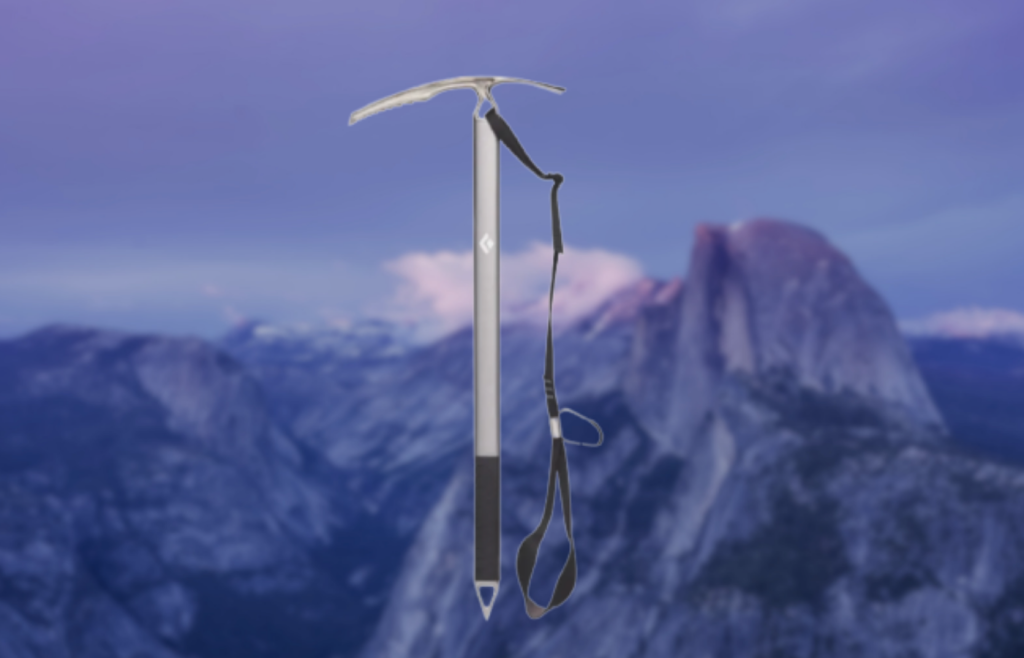
Lucy Wallace’s verdict
This is a handsome-looking ice axe with a straight shaft and elegantly shaped and comfortable head.- good value
- classic design
- simple pick
| Quick specs |
|---|
| Price: £100 |
| Weight: 451g (55cm) |
| Materials: Anodised aluminium with stainless steel head and spike |
| Technical rating: Type 1 / B |
| Grip: rubber |
| Leash or Pommel: leash included |
| Lengths available: 55cm, 60cm, 65cm, 70cm, 75cm |
| blackdiamondequipment.com |
This is a handsome-looking ice axe with a straight shaft and elegantly shaped and comfortable head, thanks to the cutaway sections for the fingers and thumb.
The stainless steel pick and adze look the part, but I would say that the pick on the Raven is the least aggressive of the tools I tested, with a subtle curve, nine gently angled teeth plus a flat top edge. This correlates with my findings when I tested it, with good performance on soft snow but less good on steeper, firmer snow or turfy rock.
Read more: Lucy Wallace’s full Black Diamond Raven with Grip review
How we test
Alex Roddie tested these ice axes on a range of day routes and short backpacking trips throughout the Cairngorms and West Highlands, including a real mix of terrain – typical easier winter walking all the way up to Grade I gullies and easy mixed ridges. Weights stated are as measured on Alex’s digital scale; note that the same length was not available from every brand, so the length of the axe tested is also stated.
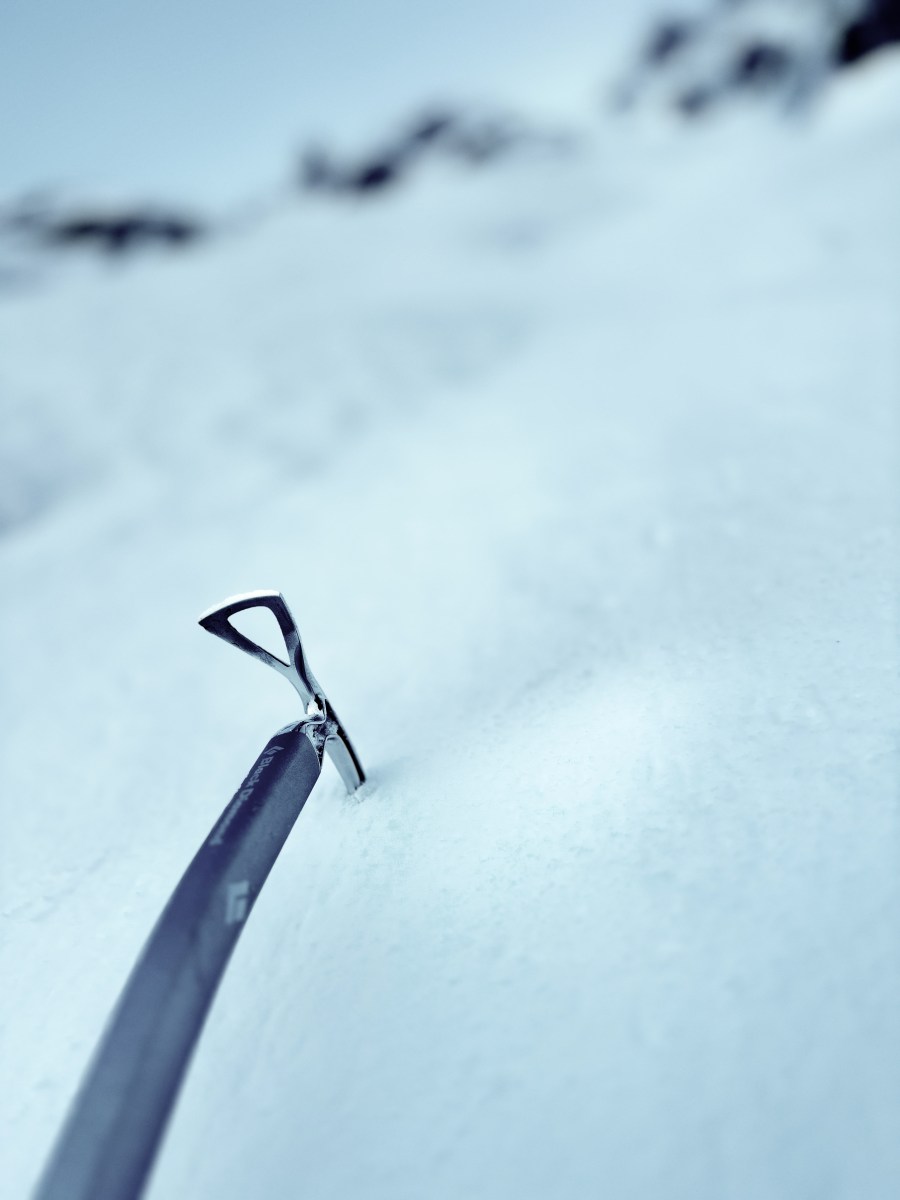
David Lintern is 5 foot 8’’, medium build but probably could have better upper body strength (these things are relevant to testing winter metalwork). He tested these axes while hillwalking and on easier graded mountaineering routes during the winter of 2022/3, from Ben Wyvis to Creag Meagaidh. He was often in the Cairngorms with two (or more!) of the review samples to allow comparison of weight, balance and performance, side by side.
In this test, David chose axes with a gently curved shaft. Why? Hardware evolves slowly, is relatively expensive to purchase and is environmentally impactful. He looks for an axe that will do winter hillwalking as well as allow some progression to steeper ground. He also wants something that will be useful should he accidentally venture out onto steeper ground. Pretending this might not happen at some point is to be in denial and he’d rather be ready. A moderately curved shaft means a far more efficient swing in axe mode and a slight curve doesn’t compromise the tool in walking mode. All axes were weighed on David’s digital scales.
Lucy Wallace reviewed axes with picks in the ‘Alpine’ style – gently curved and well suited to walking terrain and ice axe arrest. They are designed to be used singly rather than as a pair. These ice axes were all tested during the winter 2020/21 season during Lucy’s work as a Winter Mountain Leader and play (when she was locked down on the Isle of Arran). Weights were recorded without leashes on Lucy’s digital scales.
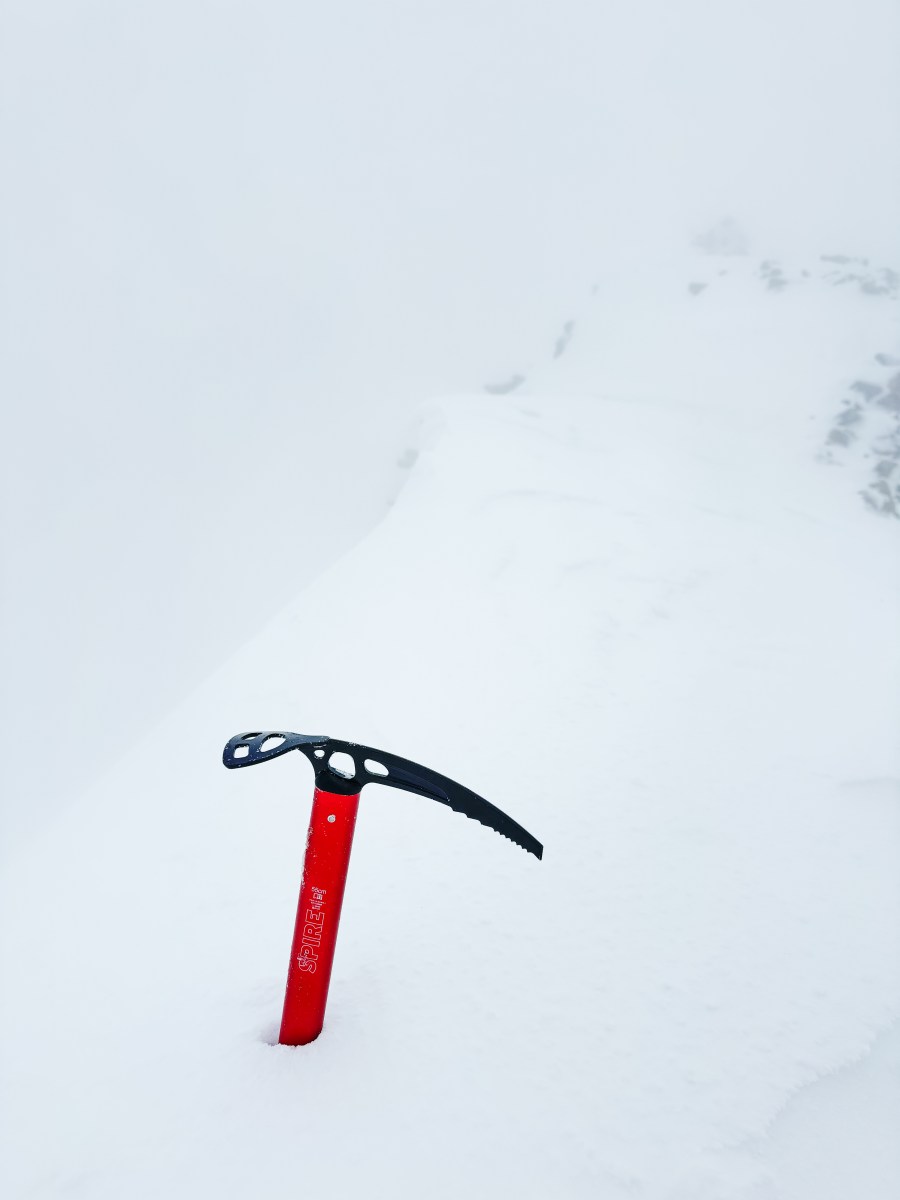
The best ice axes for you: Choosing the right length
For David Lintern, this was the most confusing aspect of choosing his first axe – everyone had different ideas. There is no ‘ideal’ minimum or maximum – it depends on your height. What size works for you also depends on the curve of the shaft, how much experience you have, the steepness of the ground you are on and how comfortable you are in your crampons, too.
Don’t let others dictate what feels comfortable – swap around with friends for an hour or so on a day out and see what feels good to you. You’ll learn loads about how you move and what different tools can offer you and you’ll soon find your fit among the best ice axes.
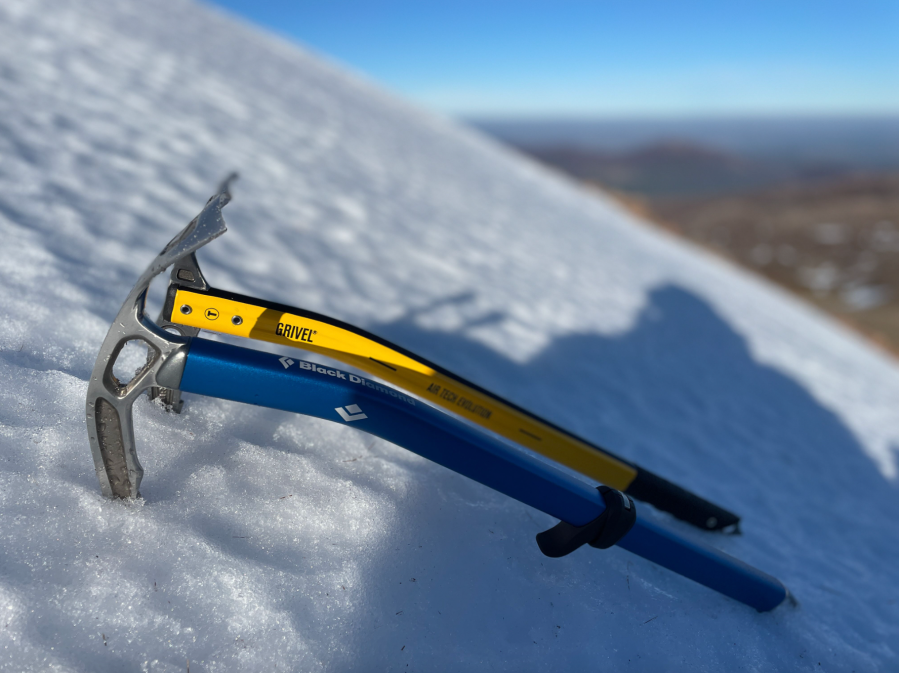
Features to look for in an ice axe
Length
The traditional method to measure the right length for you is to hold the axe by the head, at your side, with arm straight down; the spike should be at about ankle height. However, personal preference and feel are important too. For more technical routes, shorter may be better.
Shaft
Straight shafts plunge easily into snow and can be slightly better for step-cutting. A slight bend in the shaft can make the axe more secure on steep climbing terrain. A textured grip (sometimes with machined grooves) makes the shaft easier to hold.
Spike
A sharp, durable steel spike is your main point of contact with the mountain. Carbide tips set in aluminium or plastic are sometimes used; these are less secure on ice.
Adze
Used mainly for step-cutting, it’s also useful as a shovel for clearing tent platforms or belay ledges, and is important in self-arrest. A good adze is sharp and at least 5cm wide. Cutouts reduce weight but can slightly reduce effectiveness in digging (no impact on step-cutting).
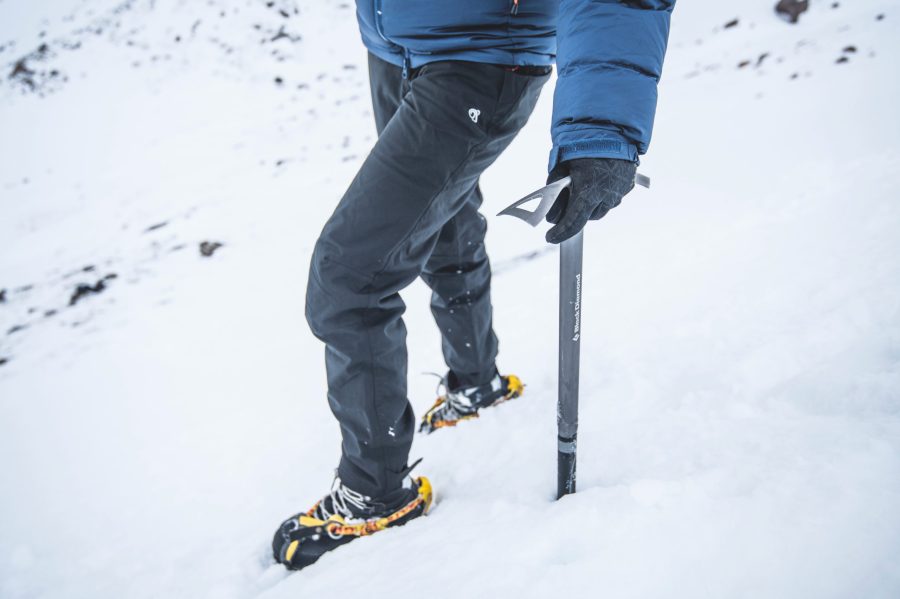
Pick
A traditional pick has a simple downward-drooping curve. This is effective when daggering or swung overhead into hard snow, and great for self-arrest, but less positive on steep ice. Reverse-curved picks point slightly upward at the tip and are better on hard ice – but can be “grabby” and abrupt in self-arrest. Teeth help to anchor in snow but don’t need to be sharp.
Weight
A lighter axe is great on the pack, but might not have the heft necessary for comfortable step-cutting or climbing. The axe should feel well balanced and natural when swung.
Technical rating
All the axes tested are rated CEN-B (Type 1), or Basic, sufficient for walking and easy non-roped climbing. CEN-T (Type 2), or Technical axes, have stronger shafts and picks for use as part of a climbing anchor.
Leash/pommel
A leash can be useful for additional security on steep ground or when cutting steps, but is usually an extra purchase and can add to the faff factor. Many people prefer to go without. More technical axes sometimes have an adjustable pommel (handrest). This is useful when climbing steep ground, but can hinder effective plunging in deep snow.

